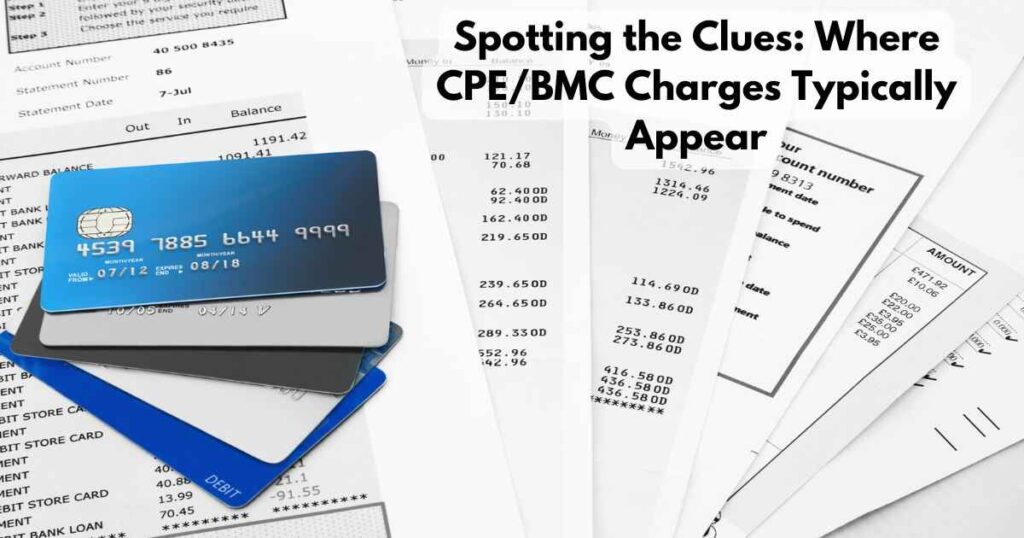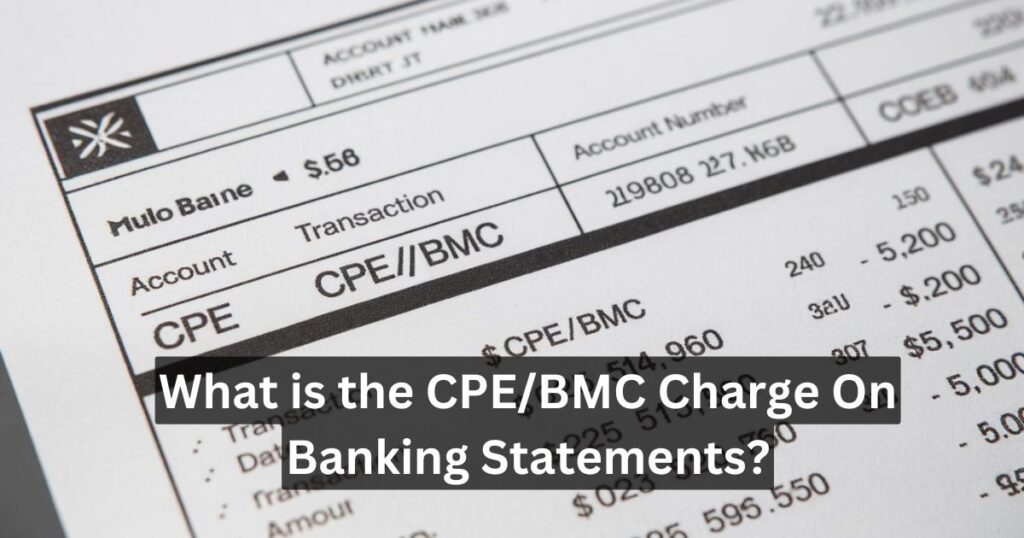Have you ever found yourself squinting at your bank statement, utterly baffled by a cryptic CPE/BMC charge? You’re not alone. These mysterious entries often leave even the most financially savvy individuals scratching their heads.
But fear not! This comprehensive guide will unravel the enigma of CPE/BMC charges, equipping you with the knowledge to navigate your financial statements like a pro.
Introduction: Unraveling the CPE/BMC Enigma
In today’s digital age, our financial lives are more complex than ever. With a plethora of transaction types and coding systems, it’s easy to feel lost in a sea of acronyms and jargon. The CPE/BMC charge is a prime example of this complexity, often appearing without explanation and causing unnecessary worry.
Understanding these charges is crucial for maintaining financial literacy and protecting yourself from potential fraud. By the end of this article, you’ll be able to:
- Identify CPE/BMC charges with confidence
- Understand why they appear on your statements
- Know how to verify and, if necessary, dispute these charges
- Implement strategies to protect your finances
Let’s dive in and demystify the world of CPE/BMC charges!
Cracking the Code: What Exactly is a CPE/BMC Charge?
To truly understand CPE/BMC charges, we need to break down the acronym:
- CPE: Card Present Entry
- BMC: Billing Merchant Code
Card Present Entry (CPE)
CPE indicates that the physical credit or debit card was present during the transaction. This typically means the card was swiped, inserted into a chip reader, or tapped on a contactless terminal. CPE transactions are generally considered more secure because they require the physical presence of the card, reducing the risk of fraud.
Billing Merchant Code (BMC)
BMC is a four-digit code that categorizes the type of business where the transaction occurred. For example:
- 5411: Grocery stores and supermarkets
- 5812: Eating places and restaurants
- 5541: Service stations (gas stations)
These codes help financial institutions track spending patterns and apply rewards or restrictions based on merchant categories.
When combined, CPE/BMC charges on your statement provide a snapshot of in-person transactions and the types of businesses you’ve patronized.
Real-world Example:
Imagine you visit your local coffee shop and pay with your credit card. The transaction might appear on your statement as:
07/15 CPE/BMC CITY BREW COFFEE #1234 $4.50This entry tells you:
- The transaction occurred on July 15th
- It was a card-present transaction (CPE)
- The merchant was City Brew Coffee, store #1234
- The amount spent was $4.50
The Usual Suspects: Common Reasons for CPE/BMC Charges
Understanding the typical scenarios that generate CPE/BMC charges can help you quickly identify legitimate transactions. Let’s explore the most common culprits:
Face-to-Face Transactions: When Your Card Meets the Machine
The vast majority of CPE/BMC charges result from everyday in-person purchases. These include:
- Retail store purchases
- Restaurant bills
- Gas station fill-ups
- Grocery store trips
In these scenarios, your card physically interacts with a payment terminal, triggering the CPE (Card Present Entry) designation.
Subscription Surprises: When Services Show Up as CPE/BMC
Surprisingly, some subscription services may appear as CPE/BMC charges, especially if you initially signed up in person. For example:
- Gym memberships
- Magazine subscriptions
- Recurring donations to local charities
Pro Tip: Keep a list of your subscriptions and their billing dates to easily identify these charges.
Read Also: Decoding the Mystery: What is FID BKG SVC LLC Moneyline on Your Bank Statement?
Merchant Mysteries: Deciphering Unknown Vendor Names
Sometimes, CPE/BMC charges may appear under unfamiliar business names. This can happen for several reasons:
- Parent companies using different billing names
- Franchises appearing under corporate names
- Small businesses using their legal names instead of their “doing business as” names
For instance, your favorite local pizzeria “Joe’s Pizza” might appear as “JDOE ENTERPRISES LLC” on your statement.
Spotting the Clues: Where CPE/BMC Charges Typically Appear

Now that we know what CPE/BMC charges are, let’s explore where you’re most likely to encounter them:
Credit Card Statements: The Most Common Habitat
Credit card statements are the natural habitat of CPE/BMC charges. These charges typically appear in a format similar to this:
Date Description Amount
07/15 CPE/BMC GROCERY STORE #123 $85.67
07/16 CPE/BMC GAS STATION XYZ $45.00
07/17 CPE/BMC RESTAURANT ABC $62.50Debit Card Chronicles: When Your Bank Account Shows CPE/BMC
Debit card transactions can also generate CPE/BMC entries, especially for point-of-sale purchases. However, they might appear slightly differently:
Date Description Debit Credit Balance
07/15 POS Purchase $85.67 $1,914.33
CPE/BMC GROCERY STORE #123Bank Statement Appearances: CPE/BMC in Your Account Activity
Even your regular bank statements may feature CPE/BMC charges, particularly if you use a debit card linked to your account. These might be listed under “Electronic Debits” or “Point of Sale Transactions.”
Detective Work: Methods for Identifying CPE/BMC Charges
Becoming adept at identifying CPE/BMC charges is crucial for maintaining financial clarity. Here are some techniques to sharpen your detective skills:
Time Travel: Examining the Transaction Timeline
- Create a personal transaction log: Keep a simple diary of your daily purchases.
- Cross-reference dates: Match CPE/BMC charges with your recorded transactions.
- Use digital calendars: Many smartphone calendars can sync with your financial apps for easy comparison.
Name Game: Decoding Merchant Identities
- Google the business name: A quick search can often reveal the true identity of unfamiliar merchants.
- Use merchant lookup tools: Websites like Merchant Category Code Lookup can help decipher cryptic business names.
- Check your receipts: The business name on your receipt should match the CPE/BMC charge.
Number Crunching: Matching Amounts to Memories
- Round numbers are suspicious: Most legitimate purchases include cents, so even amounts might warrant closer inspection.
- Look for patterns: Regular subscriptions often charge the same amount each month.
- Use budgeting apps: Many apps categorize your spending, making it easier to spot unusual charges.
By employing these methods, you’ll become a pro at deciphering your CPE/BMC charges, ensuring no mysterious transaction goes unnoticed.
Action Plan: Responding to CPE/BMC Charges Like a Pro
When you encounter a CPE/BMC charge that doesn’t immediately ring a bell, don’t panic. Follow this action plan to address the situation calmly and effectively:
- Verify, Don’t Panic:
- Check your recent receipts and transaction history
- Review your calendar for any appointments or events that might explain the charge
- Look for recurring patterns in your statements
- Merchant Communication:
- If the charge remains unclear, contact the merchant directly
- Have the transaction date, amount, and any associated reference numbers ready
- Ask for details about the product or service provided
- Future-Proofing:
- Set up a system to track recurring charges
- Use a spreadsheet or budgeting app to log expected monthly expenses
- Regularly review and update your list of subscriptions and memberships
Remember, most CPE/BMC charges are legitimate, but it’s always better to investigate than to ignore.
When in Doubt: Navigating Conversations with Your Bank
If you’ve exhausted your personal investigation and still can’t identify a CPE/BMC charge, it’s time to bring in the experts – your bank. Here’s how to approach this conversation:
- Prep Work: Compiling Your Financial Dossier
- Gather all relevant statements and receipts
- Note down the exact date, amount, and description of the charge in question
- Prepare a list of steps you’ve already taken to identify the charge
- Clear Communication: Articulating Your Concerns
- Clearly explain that you’re inquiring about a specific CPE/BMC charge
- Provide the details you’ve gathered and ask if they can offer more information
- If you suspect fraud, explicitly state this concern
- Following Through: Implementing Bank Recommendations
- Take notes during your conversation with the bank representative
- Ask about next steps and any deadlines for action
- Follow up as advised, whether it’s monitoring your account or filing a formal dispute
By approaching your bank with organized information and clear communication, you’ll be more likely to resolve any issues quickly and effectively.
Read Also: Unlocking the Future: Why is Foresight Not Getting Traction with Business?
Fortifying Your Finances: Preventing Unauthorized CPE/BMC Charges
While understanding CPE/BMC charges is crucial, preventing unauthorized ones is even more important. Here are some strategies to protect your finances:
- Smart Payment Strategies:
- Use virtual card numbers for online purchases
- Consider contactless payments for enhanced security
- Opt for credit cards over debit cards for better fraud protection
- Vigilance is Key:
- Set a weekly reminder to review your transactions
- Use mobile banking apps for real-time monitoring
- Pay attention to small, unfamiliar charges – they could be test runs for fraud
- Tech to the Rescue:
- Enable transaction alerts on all your accounts
- Set up two-factor authentication for online banking
- Use a password manager to maintain strong, unique passwords for each financial account
By implementing these measures, you’ll create a robust defense against unauthorized charges and financial fraud.
Conclusion: Mastering the Art of CPE/BMC Charge Management
Decoding CPE/BMC charges is more than a financial skill it’s a gateway to empowerment. By understanding these cryptic entries, you’ve armed yourself with the knowledge to navigate the complex world of modern banking. Remember, each CPE/BMC charge tells a story of your financial journey.
Stay vigilant, trust your instincts, and don’t hesitate to investigate when something seems amiss. Your newfound expertise will serve as a shield against fraud and a tool for better budgeting. As you move forward, carry this knowledge with pride. You’re not just reading your bank statements; you’re mastering your financial narrative.
Frequently Asked Questions
What is the full form of CPE in banking?
CPE stands for “Card Present Entry” in banking. It indicates that a physical credit or debit card was used for the transaction, typically through swiping, inserting, or tapping at a point-of-sale terminal.
What does CPE BMC mean?
CPE BMC stands for “Card Present Entry / Billing Merchant Code.” This combination provides information about both the type of transaction (in-person card use) and the category of the merchant involved in the transaction.
What are the three most common fees that can be seen on a bank statement?
The three most common fees on bank statements are typically:
- Monthly maintenance fees
- Overdraft fees
- ATM withdrawal fees (especially for out-of-network ATMs)
What is charge code in banking?
A charge code in banking is a specific identifier used to categorize different types of transactions or fees. It helps banks and customers quickly understand the nature of a charge, such as whether it’s a purchase, a fee, or a specific type of service.





